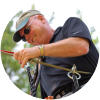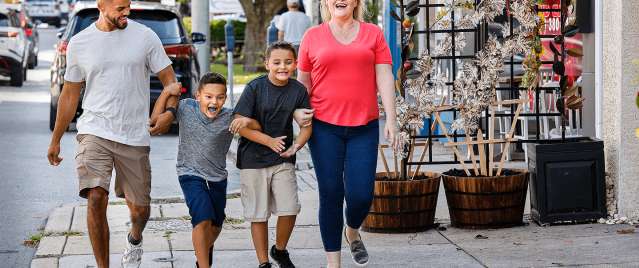What comes to mind when hearing the word "snowshoe"?
If you're anything like me, it's a pair of tennis-racket shaped footwear worn by Yukon Cornelius in Rudolph the Red Nosed Reindeer.
But like most sports equipment these days, the snowshoe evolved decades ago, leaving behind the wooden frames and leather fastenings. Now, they are barely larger than a pair of running shoes, with Velcro straps that are both convenient and effective.
My education in the sport of snowshoeing came from a pro: Ed Myers, race director for the annual Pennsylvania Snowshoe Race at Spring Mountain, scheduled for January 30.
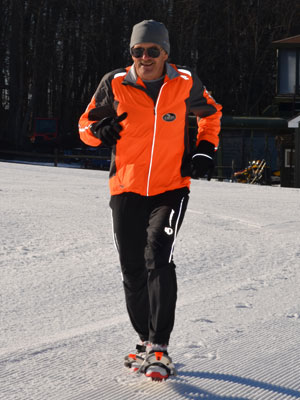 "I'm from upstate New York," Myers says. "I've been snowshoeing since I was a kid." At 65 years old, that's a lot of experience trekking over drifts.
"I'm from upstate New York," Myers says. "I've been snowshoeing since I was a kid." At 65 years old, that's a lot of experience trekking over drifts.
Myers was quick to point out, however, that the sport can be embraced by athletes of all ages and abilities. "We like to say that there's no real learning curve involved in using snowshoes. You may hit an ankle every now and then when first putting them on, but after a couple of times, you'll wise up and spread your stride a little bit. The average trail runner, when putting them on, will go, ‘Woah. That's a lot of fun!'"
As evidence of just how easy it is to adapt to snowshoeing, Myers helped me strap on his pair. They went directly over my hiking shoes, and before long, I was covering ground at the base of Spring Mountain.
The cleats were a definite plus, propelling me forward over the slippery surface.
"There's no need to look down, Dan," Myers told me. "Look where you're going, not at your feet. They're not going to come off."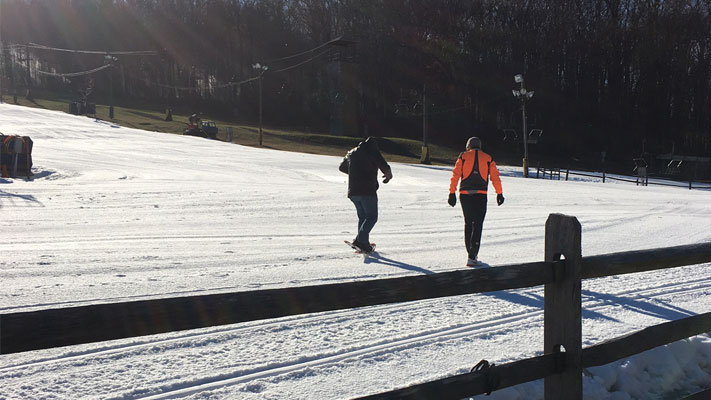
He was right. Head up, my progress got easier.
Ordinarily, a snowshoe race is held on a trail or open plain (perhaps a snow-covered golf course), where competitors can sprint on foot much the same way a cross-country skier glides over the landscape. But finding expansive areas of snow - especially this winter here in Montgomery County - can be difficult.
The terrain at Spring Mountain offers the snow cover, but not the possibility for great distances. The solution came in the course layout, which traverses the mountain, crisscross style, to give participants a full 5k.
Originally, snowshoes were designed merely to assist in navigating deep snow; their width helped distribute body weight and prevent sinking into deep drifts.
Nowadays, especially on the competitive front, their design has evolved to include the ability to aid in traction.
"Mine have these titanium cleats on the bottom," Myers explains, turning his snowshoes over. "It's like having grizzly bear teeth on the bottom of my feet.
 "I have three sets of cleats that I can interchange very quickly. If it's deep snow, I have deep snow cleats, ice cleats and a set of cleats for medium snow."
"I have three sets of cleats that I can interchange very quickly. If it's deep snow, I have deep snow cleats, ice cleats and a set of cleats for medium snow."
Myers' passion about his sport is clear. "Everybody needs something," he says. "In winter, this helps keep me fit.
"But there's also a camaraderie involved in competing in below-freezing temperatures, falling snow and high winds. For example, in one of my 5Ks, I was closing in on first place, getting right up behind the leader. And all of a sudden, I was in the snow, face first.
"The guy that I was ready to pass stopped, came back and helped me up. And we looked down at my shoe, which had broken. He whipped out a roll of duct tape - right from his pocket - wished me good luck and ran off to the finish line.
"It was 15 below zero. As I was struggling to get the duct tape out of the roll with my bare hands, the guy that was behind me came up. And he gave me his roll of duct tape and continued.
"What I figured out is that two of my aluminum rivets had popped. I ended up doing was - you know the kids' game where they skip over a ring that hangs on one ankle? What I had was my shoe was spinning around the rivet. So with each step, as it rotated around, I hopped over it and onto the finish line."
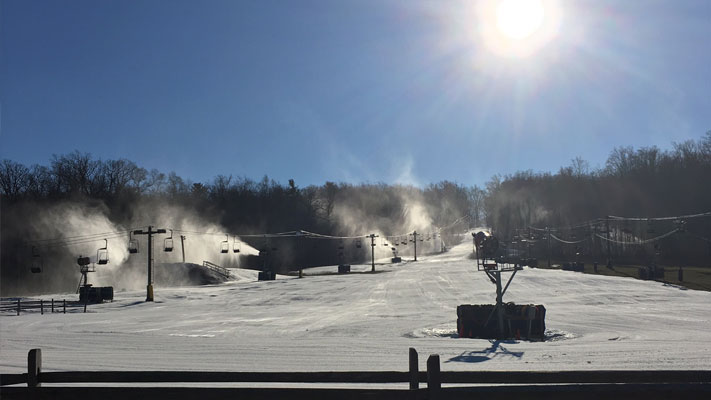
Despite the equipment failure and the time delay, Myers mustered the determination to finish third.
 The 2016 Annual Snowshoe Race at Spring Mountain is January 30. Registration begins at 7 a.m., and the starting gun sounds at 8 a.m. All competitors are welcome, including beginners. The $25 online entry fee ($30 day of event) includes refreshments, awards, goody bag, raffle, associate membership in USSSA.
The 2016 Annual Snowshoe Race at Spring Mountain is January 30. Registration begins at 7 a.m., and the starting gun sounds at 8 a.m. All competitors are welcome, including beginners. The $25 online entry fee ($30 day of event) includes refreshments, awards, goody bag, raffle, associate membership in USSSA.
Spectators are more than welcome to cheer on their favorites.
A day of bracing athletics in the snow calls for a warm place to retreat afterward. Competitors and fans can both end their day by snuggling into one of the signature hotel rooms listed on our website.




